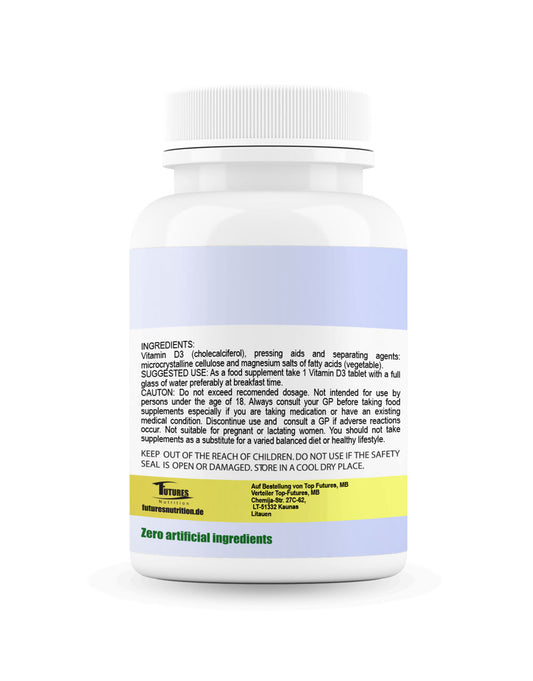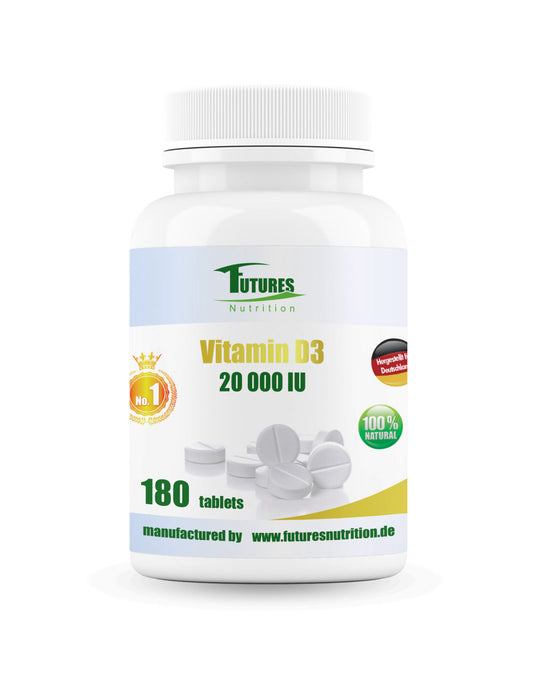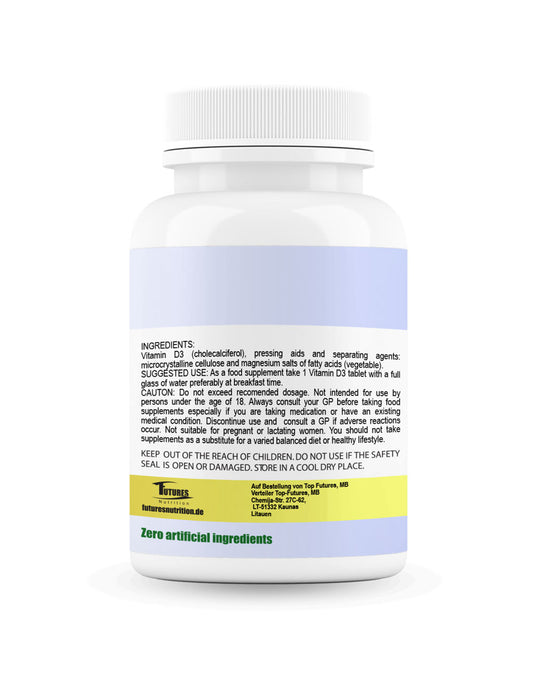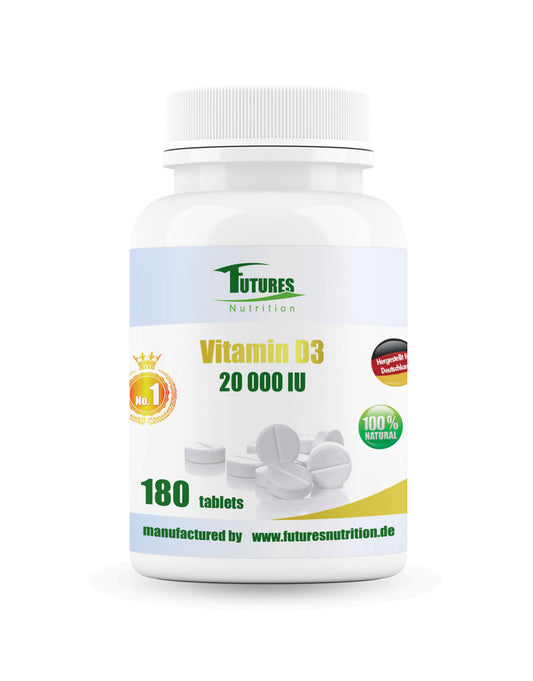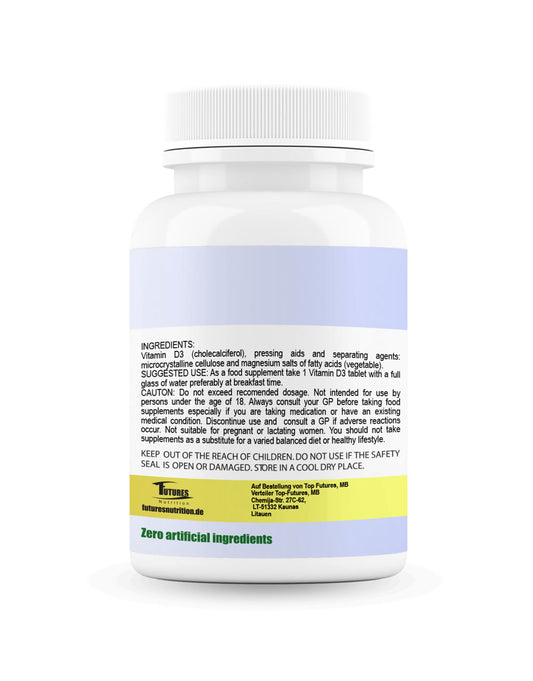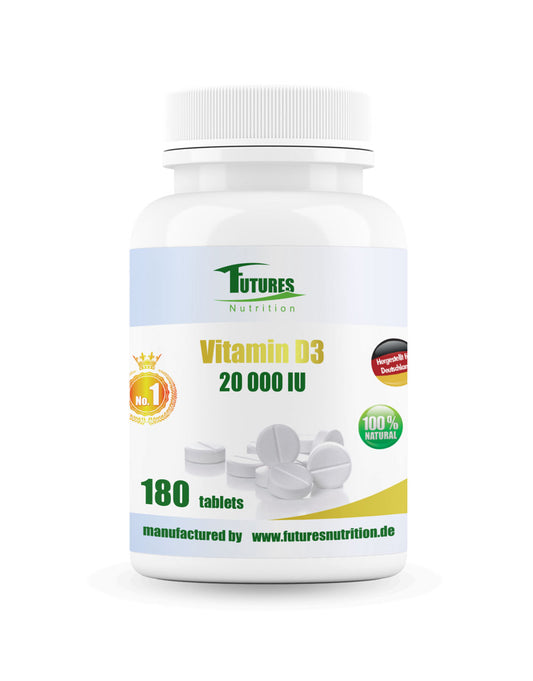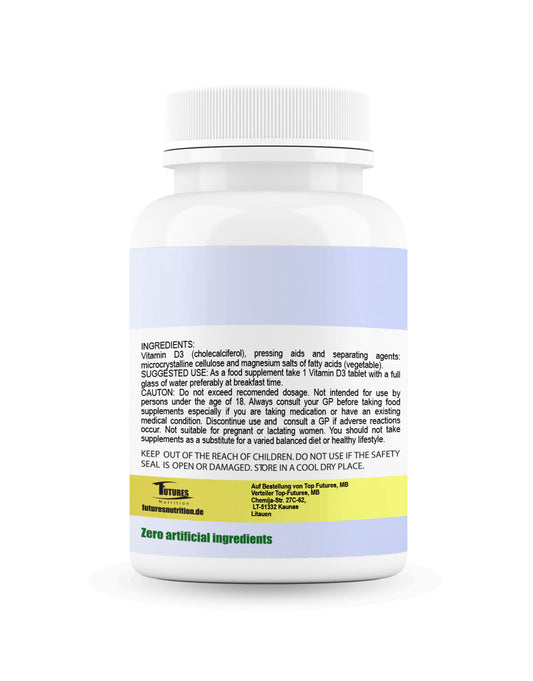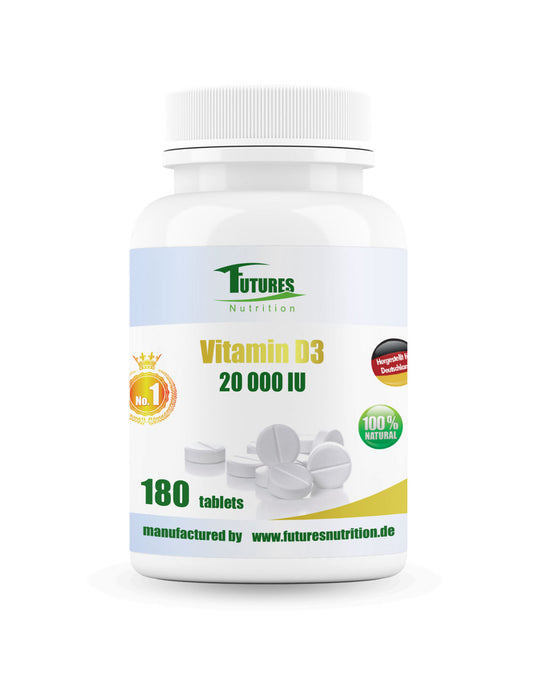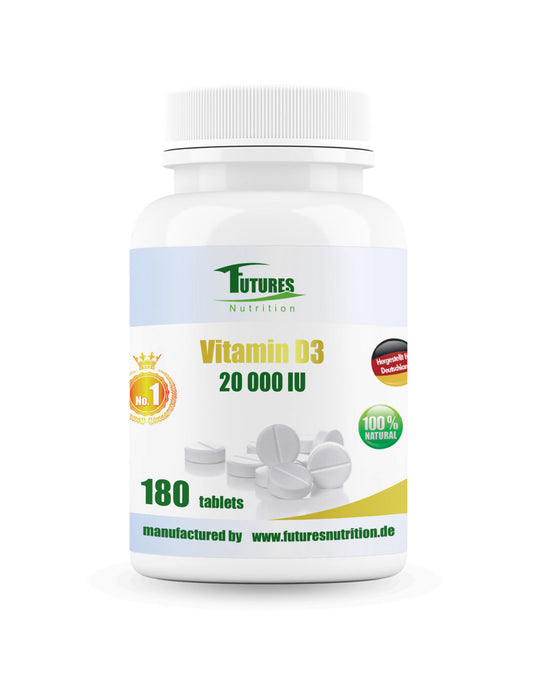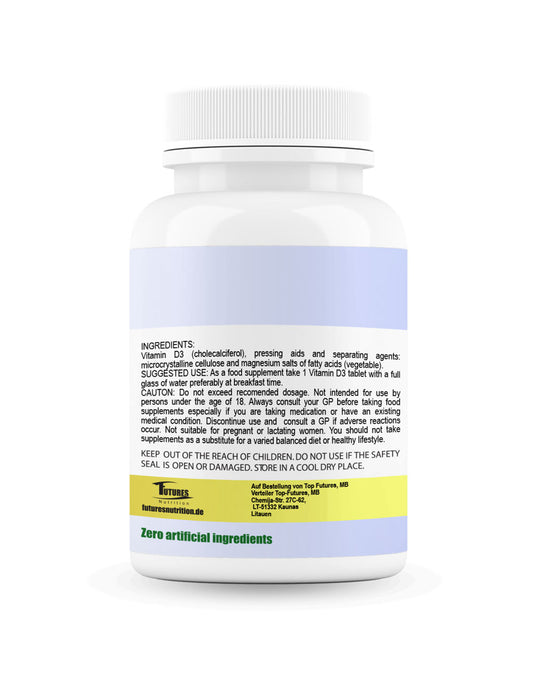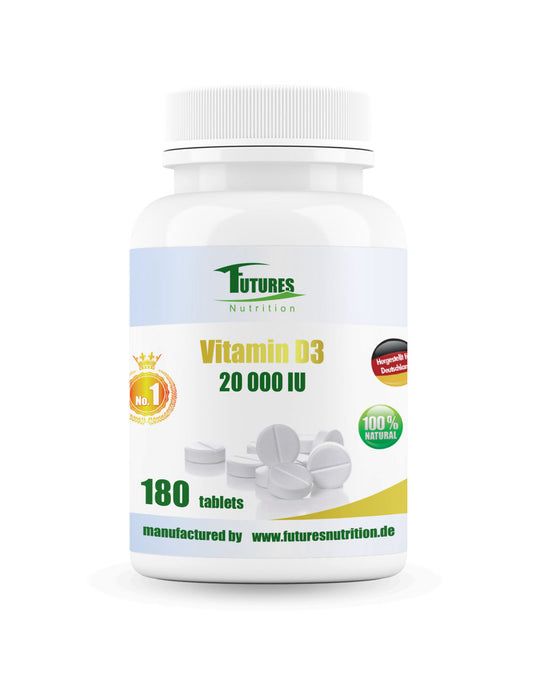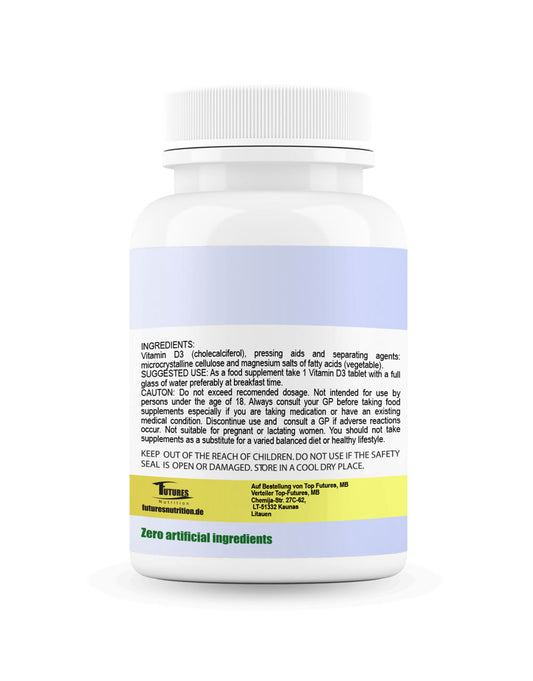Thank you for fast delivery and perfect product.
Collection: .
How much vitamin D3 should I take a day?
The recommended daily vitamin D3 feed over the food depends on how much sunlight receives a person, and is hard to determine because the sun's radiation of person is different to person and depends on various factors such as the season and place of residence; For this reason, the recommendations assume that a person is exposed to a minimum amount of sunlight. According to the recommendations of the Institute of Medicine, the recommended amount of vitamin D3 is in the food to improve bone health as follows:
- 600 international units (IE) for persons aged 1 to 70 years.
- 800 ies for persons over 70 years.
The dose of vitamin D, if you have a defect:
Adults with a vitamin D deficiency of less than 30 ng / ml is recommended to take vitamin D doses to restore the normal vitamin D levels in the following doses:
- Daily dosage: It is recommended to take 1500-2000 IE Vitamin D daily.
- Weekly or Monthly Dose: Take Vitamin D3 20,000 IE or 50,000 IE weekly or monthly.
The intake of too much vitamin D3 leads to vitamin D toxicity, which is rare and can not be caused by taking vitamin D from foods or due to solar radiation, but usually by taking high doses of vitamin D -Honte dietary supplements. Poisoning occurs when vitamin D3 is taken over several months daily at a dose of 20000 ie, and vitamin D toxicity can lead to hypercalemia, which causes the following symptoms: nausea, constipation, increased urination, increased thirst, general Weakness. Anorexia.
Vitamin D3 benefits
Vitamins are one of the necessary and important elements for the construction of body tissues, and under these vitamins is vitamin D3 20000 IE, known as cholecalciferol. The benefits of this vitamin for the body are:
- The body is instructed to accommodate calcium and phosphorinominals from the food or dietary supplements, which contributes to strengthening the bones and protects them from bone breaks, brittle, and rachitis.
- Vitamin D3 20000 IE plays an important role in improving the mood and the prevention of mental disorders such as depression.
- For kidney diseases because it contributes to maintaining the calcium level in your body.
- Required for patients with diseases such as hypothyroidism, hypophosphatemia and hypoparathyroidism.
- Useful for infants, especially if the breast milk is not sufficient due to a lack of vitamin D in the body of the mother.
- Strengthens immunity.
- Reduces the effects of some diseases such as diabetes, hypertension, ovarian cancer, heart disease, breast cancer and colon cancer.
- Strengthens teeth and bones.
- Activates and regulates the growth of different cells in the body.
Vitamin D2 opposite D3
Vitamin D is an important vitamin for the health of the body and lies in two forms that have a similar chemical structure: Vitamin D2 (Ergocalcififerol) and vitamin D3 (cholecalciferol).
In fact, both types of vitamin D cover the needs of the body, but the difference between vitamin D2 and D3 is in some important points we explain below:
Sources:
Natural sources: The difference between vitamin D and D3 is that vitamin D3 can be obtained by the action of the ultraviolet rays of the sun.
Food sources: Vitamin D3 is included in food from animal sources, while vitamin D2 can be obtained from vegetable sources and enriched foods.
Here are some food sources for each of them:
Sources for vitamin D3: fat fish, fish oil, egg yolk, butter, liver and dietary supplements.
Sources for vitamin D2: mushrooms, enriched foods and dietary supplements.
Production:
The difference between vitamin D2 and vitamin D3 with respect to the production is that vitamin D3 can be synthesized by the action of sunlight, since dehydrocholesterine, which occurs in the layers of the skin, converted by the action of UV rays in vitamin D3 will. Similar to plants, vitamin D2 is formed from the ergosterol compound which occurs in vegetable oils.
effectiveness
Some one likes to ask what the difference between vitamin D2 and vitamin D3 is in relation to its effectiveness in the body and which of the two is stronger.
It seems that the difference between vitamin D2 and D3 is in terms of their effectiveness in the different ability to increase the vitamin D levels in the body.
Although both are included in the bloodstream, they are metabolized in the liver, whereby vitamin D2 is converted into 25-hydroxyvitamin D2 and vitamin D3 in 25-hydroxyvitamin D3, both of which are referred to as Calciferol.
However, vitamin D3 produces more Calciferol as vitamin D2, as the results of vitamin D analysis in persons show vitamin D2 and vitamin D3 preparations.
Additions:
Here are some important differences between a vitamin D2 supplementation and a vitamin D3 supplementation:
Composition:
A vitamin D3 supplement preparation corresponds to the natural vitamin D3, which forms the skin by the action of sunlight, while vitamin D2 is not produced naturally in the human body.
Toxicity:
The toxicity of vitamin D is different depending on the type. The toxicity of vitamin D3 is probably less than that of vitamin D2, which is due to the different ratios in binding to the vitamin D receptors in the body.
Stability:
Vitamin D3 is more stable than vitamin D2 so that a vitamin D3 supplement is likely to remain more effective under different conditions such as temperature fluctuations and changed storage conditions.
-
2 x Vitamin D3 20000i.e 360 tablets
Regular price €19,79Regular priceUnit price / per€17,99Sale price €19,79 -
Vitamin D3 20000i.e 180 tablets
Regular price €15,50Regular priceUnit price / per -
3 x Vitamin D3 20000i.e 540 tablets
Regular price €27,49Regular priceUnit price / per€24,99Sale price €27,49 -
100 x Vitamin D3 20000i.e 18000 tablets
Regular price €604,98Regular priceUnit price / per€549,98Sale price €604,98 -
10 x Vitamin D3 20000i.e 1800 tablets
Regular price €84,68Regular priceUnit price / per€76,98Sale price €84,68 -
5 x Vitamin D3 20000i.e 900 tablets
Regular price €43,99Regular priceUnit price / per€39,99Sale price €43,99 -
50 x Vitamin D3 20000i.e 9000 tablets
Regular price €362,98Regular priceUnit price / per€329,98Sale price €362,98


